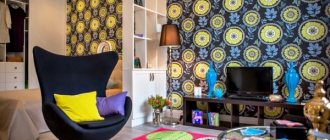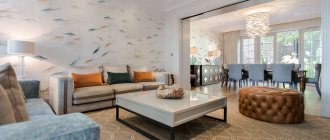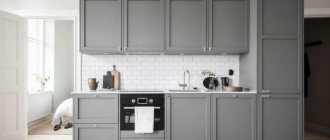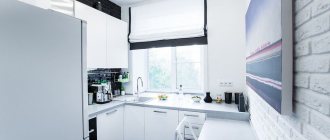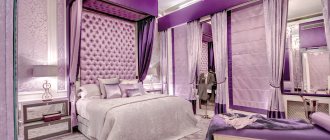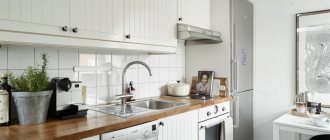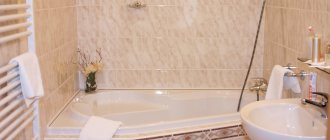SHARE ON SOCIAL NETWORKS
FacebookTwitterOkGoogle+PinterestVk
From this article you can learn how to choose combined wallpaper for the living room: photo, design 2017-2018, used for decorating large and small rooms, recommendations from professionals. The text contains useful information on the selection of materials and rules for combining finishes, taking into account its palette, decorative component, texture and other characteristics.
Combining wallpaper allows you to highlight advantageous areas of the living room and hide layout flaws
Combined wallpaper for the living room 2017-2018: photos, interior design and fashion trends
Every year designers continue to surprise with new textures and combination options. The trends of the past year have prepared us for the return of bright accents. On the one hand, it is the embodiment of the dynamic rhythm of life. On the other hand, a return to the fashion of the 80s with bright colors. Interesting options for how to combine wallpaper in the living room are presented in our photo selection at the end of the article.
The TOP 8 includes the following areas:
| Color | Recommendations for use in the interior |
| Juicy yellow | A few bright accents in the interior or decor are enough for the overall perception to completely change. This is the color of sun and joy. |
| Rich green | It has been popular for several seasons. However, the dark one is replaced by a noble shade. This color harmonizes well with rich purple and muted blue shades. |
| Black | Black, but only as a neutral tone to complement the main color. |
| White | In combination with black, you can change the geometry of the room. For example, for small rooms the main palette is white, black can be present as an addition. Conversely, large blacks are favorably emphasized as the main color, and white is needed only for balance. |
| Serene blue-gray-green | This range calms the interior, giving a feeling of coolness and peace. |
| Blue with orange | The combination will add positive energy to the room. Examples of such combined wallpaper for the living room can also be seen in the photo selection at the end. |
| Pink | This color is no longer associated with belonging to the feminine trend. Designers offer sophisticated shades combined with pastel tones for a vibrant decoration. |
| Brick and terracotta shades | Suitable for large areas. They fill the room with warmth and comfort, especially if there is a fireplace area in the living room. |
The entire color palette fits perfectly into the trendy interior design styles.
An interior that will fill you with warmth
Fashionable wallpaper design for 2022 in the style of the 50s and 60s. - geometric patterns
According to interior designers, using an ordered structure of geometric patterns in arrangements is quite appropriate. In 2020, wallpaper manufacturers will definitely offer models inspired by the style of mid-century modern and, therefore, the mid-20th century. Which trendy wallpaper design 2022 is worth considering? Along with complex patterns in pastel colors, the new products will also include wallpapers in simple patterns based on circles or curves, in strong and very fashionable colors taken from a previous era.
Consider options in colors such as mustard yellow, terracotta orange, navy, olive, jade green, and chocolate brown or warm gray. Monochrome wallpapers with geometric patterns, such as repeating or asymmetrical patterns, will also be among the hits of 2022. Black and white wallpaper is a particularly good choice for people who want to liven up their interiors without necessarily bringing in color.
How to beautifully combine wallpaper in the living room
The use of combined wallpaper is a favorite technique of designers. But before you combine wallpaper in the room with each other, you should look at photos of ready-made collections from manufacturers or think about your own combination. These options will help you create your own unique interior.
Nowadays it’s rare for anyone to settle on the same type of design. Designers insist on using combinations of texture, shade or pattern. This technique can advantageously emphasize a certain area.
Advice! Before choosing wallpaper, you need to take into account the location of the room, geometry, presence of protrusions, ceiling height, lighting. All these nuances can be very advantageously played out; negative aspects can be turned into advantages with the help of the right choice.
Basic combination techniques
There are a lot of options for combining wallpaper in the room. Photo ideas can be found in manufacturers' catalogs. Let's list some of them:
- The most common one is that one wall stands out with a brighter texture, all the rest are done in a calmer palette;
- An interesting decision would be to cover two adjacent walls with one type with a brighter pattern or geometry, and the other two in muted shades;
- it can be combined by alternating the horizontal gluing technique with the vertical one;
- diagonal gluing is quite difficult to perform, but it will give a completely different look to the living room;
- You can use stripes to emphasize certain areas, for example, a relaxation area, a fireplace, a TV, or an entrance area;
- Stripes decorated in baguette frames look impressive. They give the interior some bohemianism.
Non-standard allocation of a recreation area
Before you buy wallpaper
Before purchasing, you need to calculate the required amount of material so as not to end up in a situation where a couple of centimeters are missing. Traditional wallpaper is produced in rolls of a standard length of 10.5 m. The width of the rolls varies (0.5, 0.7, 1.0 m).
Take into account the differences in wallpaper in terms of area covered. This is a very important point. Measuring the hall lengthwise and crosswise with a tape measure will help determine the required quantity. The value after multiplication will be the area of the working walls.
Next, you need to subtract the area of the windows and doors from the resulting area. The doors between the rooms are almost the same, 2.0 x 0.8 m. The same applies to the windows. The standard dimensions of window openings are 1.75 × 1.6 m. This means that 1.6 and 2.8 square meters must be subtracted from the total area of the hall. m, respectively.
If the renovation plans include combining a living room with a kitchen or bedroom, then you should calculate the area for each room separately. In this case, you can use different wallpapers.
You will be making a mistake if you think that this is where the area has been calculated. There are many more nuances, for example, trimming, tolerance, pattern adjustment, non-standard ceiling height. A standard roll is designed for a room height of 2.6 m. Thus, 4 strips are obtained from one roll. If the ceiling height is higher, then much more wallpaper will be required.
Advice: it is better to buy more wallpaper per roll. You can arrange to return the unused packaged roll back to the store. This is a better option than a lack of finishing material. Remember that different batches of wallpaper differ in shade. In addition, the store may no longer have the required rolls.
The right choice of wallpaper to combine
In the design of a room, you can use not only a combination of wallpaper colors, but also interesting textures. Manufacturers have taken into account the wishes of professionals and offer collections with a combination of print and pastel options.
We offer some tips for choosing a combination with plain wallpaper:
- flowers or plants;
- abstractions;
- wide stripes;
- ornaments;
- photo wallpaper for the hall with a floral print or a fragment of the city.
Geometric patterns have become quite popular lately. Prints can have clearly defined lines or spread across the surface, creating the illusion of volume. They can be made of 2-3 colors. In catalogs of various apartment designs, you can choose interesting photos of combined wallpaper for the living room.
Geometric print creates movement
Textile wallpaper: unusual
Textile wallpaper looks very interesting. Various interior solutions can be implemented when arranging your room.
Silk-screen wallpaper is characterized by shine and silkiness
Textile wallpaper is based on natural or artificial fabric, which is attached to a paper backing. The distinctive features of this product include:
- environmental safety;
- variety of textures, due to the use of different threads;
- Textile wallpaper is based on paper, non-woven fabric, which is covered on top with cotton, linen or viscose fabric;
- resistance to fire;
- rich variety of design;
- bactericidal properties.
The finishing layer of velor wallpaper resembles fabric.
A type of textile wallpaper is velor: first a pattern is applied to it, and only then velor fibers. As a result, the wallpaper has a soft, velvety surface. On the other hand, textile products are not resistant to abrasion or mechanical stress, and they can only be glued to smooth walls without defects.
Basic rules for combining wallpaper of two colors in the living room
The combination of two shades is a simple technique; it is suitable for those who are taking their first steps in interior design. You can select different tones of the same color scheme. The interior turns out to be quite calm and harmonious with its own charm.
Shades of blue, sand, gray and green are a win-win when combining wallpaper for a living room. Photos of apartments with a calm interior are posted in many galleries of fashion designers. You can experiment and complement the interior with a third shade from the same color scheme. On the wall, paste with a smooth transition from a light tone to a darker one and vice versa.
You should know this! Bright shades are suitable for the interiors of active people, light colors - for calm people.
Related article:
Wallpaper for the living room in the apartment. The photo ideas in this article will help you decide on the right choice, and the advice of professional craftsmen will allow you to correctly glue the canvases with your own hands.
By type of materials
Despite the fact that the living room and hall are universal rooms, and wallpaper of any type is suitable for decorating such interiors, due to design differences, many resort to combining a variety of coatings - paper-based, vinyl, non-woven and even fabric coverings - within the same space . This approach requires great care, and the gluing process itself can take much longer, since each type of wallpaper has its own operating characteristics.
When choosing wallpaper of different types for a living room or hall, make sure in advance that you have wallpaper glue suitable for each of these materials. It is advisable to consult with specialists about special types of glue for simple and complex (heavy) wallpaper coverings.
Some companies produce universal types of glue that are suitable for all types of wallpaper products (for example, Semin Murale and Quelyd Murale brands).
It is especially difficult to combine standard wallpaper with textile coverings. Due to the originality of the texture and thinness of the canvas, you will not be able to disguise the joints and transitions between these materials. The easiest way to create a harmonious transition is with borders and moldings.
Basic nuances and rules for gluing when combining
Before pasting, you should first prepare the wall surfaces: remove the old coating, putty, and clean. Before gluing thin, plain wallpaper, the walls must be aligned almost perfectly. The textured coating allows for minor errors. Examples of such work are presented in photo catalogs of wallpaper for the living room in an apartment from various manufacturers.
Vertical gluing of combined wallpaper is usually not difficult. Before starting work, you should mark the line with a level and then stick to it. When pasting wallpaper of different textures, different adhesive compositions may be needed.
Combination options
Glass wallpaper: modern
This type of wallpaper is a decorative covering, the structure of which resembles fiberglass fabric. The finishing material is based on natural materials that do not emit harmful substances into the room. The starting material is special glass, which is heated, after which fibers of different types and thicknesses are drawn from it.
Glass wallpaper is very durable and easy to clean
Advantages of glass wallpaper
This wallpaper is an excellent solution to transform the interior of a room and bring something new to it. Distinctive features of the products include:
- resistance to combustion, moisture;
- ensuring natural diffusion;
- creating a favorable indoor microclimate.
How can you correct wall imperfections by combining wallpaper?
Using wallpaper you can smooth out some finishing defects. Basic techniques and tricks for correcting the nuances of apartments using wallpaper in the living room are presented in photo collections of various masters on the Internet. We suggest considering several effective solutions:
- Unevenness or slight curvature of the surface can be visually hidden using a bright print or stripes with a dense texture and relief. But plain ones, on the contrary, will highlight all the flaws;
- small repair errors are well hidden when alternating plain and patterned stripes. You can experiment with shade, smooth and foamed surfaces;
- light stripes visually expand the space. This is very important for small apartments. A narrow room can be expanded by gluing long walls with light wallpaper, and wide walls with slightly darker materials;
- the small height of the room can be visually increased if the stripes are not glued to the ceiling, but left about 10 cm. Alternating light and dark stripes also visually increases the height;
- The technique of horizontal wall division is used only in rooms with high ceilings. The wall is divided into three parts. 1/3 below can be covered with dark-colored canvases, above - with calmer light shades.
Visual expansion of space
What wallpaper to choose for the hall to make the room seem larger than the photo
To solve the problem of a small space, the chosen color scheme plays an important role. Designers advise using light shades in small rooms: light pink, beige, light blue and other colors from the pastel palette. Avoid flashy colors, sharp contrasts and dark, heavy colors.
Also keep in mind that the blue color creates the impression of some distance of objects, while warm orange tones, on the contrary, bring them closer. Therefore, in order not to lose the sense of comfort in an effort to expand the space, you should not use bright and dark colors. In addition, you do not need to use wallpaper with large patterns. If you have chosen wallpaper to decorate the room, then you need to take into account the optical effect that is created by the combination of different colors and patterns.
Also, when choosing wallpaper, it is worth remembering that:
- large patterns on wallpaper significantly reduce space;
- You can make the room taller using plain wallpaper with vertical stripes;
- wallpaper of different colors, separated by a border, will visually narrow and make the room smaller;
- Single-color wallpaper with a small pattern will help to enlarge a small room;
- if on one wall there is wallpaper with a larger pattern than on the other walls, then such a wall will visually expand the space;
- You can liven up a dark room by gluing wallpaper of the same color, but a shade lighter, to the least lit wall.
Soft pastel colors relax and induce sleep, so they are recommended for use in a child’s room. A cozy atmosphere can be created with the help of warm shades: cream, beige, green and yellow. These tones are best suited for the dining room and living room. Bright colors and fiery colors relieve fatigue and charge you with cheerfulness and energy. They are recommended to be used to decorate a home gym or office.
Wallpaper combination techniques
There are several standard techniques for how to beautifully hang wallpaper in a living room. You can always make your own adjustments and come up with something unique. But for each case, in order for the room to look harmonious, you need to adhere to the basic rules.
You should know this! The materials to be combined must have something in common: texture, pattern or color. For example, if a bright print is chosen as an accent, the remaining walls should repeat its main shades.
Horizontal combining
This technique is suitable for rooms of regular geometry without protrusions and niches. The wall is conventionally divided into two lines, the lower part should be no more than 130 cm. The junction can be emphasized with a border, polyurethane strip or molding.
Dark shades are suitable for the lower part; stripes, small patterns or bright geometry can be used for the upper part. You need to choose materials based on the overall interior design.
For high ceilings, another technique is suitable, which has become quite popular lately: alternating horizontal stripes across the entire surface of the wall. You can make a horizontal division using an arbitrary wavy line. This is quite difficult to do, but such a surface looks very unusual.
Double horizontal combination
Vertical combination
Vertical combinations are much easier to perform than horizontal ones. This can be alternating stripes in a checkerboard pattern, or highlighting a specific surface. The canvases can be selected in the same color scheme, or you can alternate a bright pattern with a monochromatic one.
You can cover 2 walls with the same wallpaper. And it is not at all necessary to select canvases of the same width. Wide and narrow stripes will also act as independent wall decoration. The photo catalogs present wallpaper for rooms in different techniques.
Vertical combination
Combination with inserts
The gluing technique with inserts gives the interior solemnity and elegance. The inserts act as paintings in the interior; you can arrange them in the form of posters by choosing a harmonious design.
It is recommended to cover the main walls with plain wallpaper. Textured inserts are glued on top. In order to emphasize accents, you can frame them in frames made of polyurethane slats or moldings of small width. The gluing technique with inserts allows you to use materials of different textures.
Inserts matched to the upholstery of upholstered furniture
Patchwork patchwork technique
This is last year's discovery. The technique of sewing patchwork quilts is taken as a basis. The composition is created from different pieces of material, which are then created into a whole composition.
Now it has become quite fashionable to make beautiful wallpaper for the living room with your own hands. Here, too, you will need a lot of imagination and patience. The result will be a single copy of the artist’s canvas. To begin with, you can take 3-4 wallpaper options, which are made in compatible shades. Stripes for combining should be selected that are similar in texture or pattern.
You should know this! The only thing that is unacceptable for such technology is the combination of expensive wallpaper with cheap ones.
When preparing sections of wallpaper, you need to ensure that they have different geometries and sizes. Only in this case will the necessary decorative effect be achieved. To simplify the work, you can create a composition from pieces of the same width but different lengths.
Patchwork technique
Advantages of using wallpaper for interior decoration
It is not for nothing that wallpaper has been occupying the highest places in the top lists of current finishing materials for many years. Whatever finishing options manufacturers offer us, wallpaper fabrics have a sufficient number of advantages:
- the widest selection of colors, patterns, ornaments and various prints;
- the ability to choose a textured surface;
- ease of application of finishing material, possibility of self-installation even without experience;
- With wallpaper you can quickly refresh the interior of a room or change its appearance completely;
- highlighting an accent wall is not difficult; by combining wallpaper and other finishing materials you can create interesting, unique interiors;
- high aesthetic qualities;
- the possibility of creating decoration in rooms with a high level of risk of contamination - wallpaper that can be washed and even cleaned;
- modern canvases do not fade in the sun, are able to withstand temperature changes and fairly high humidity;
- the possibility of using absolutely environmentally friendly materials (natural linens, paper and cork wallpaper);
- Wallpaper can be printed with any image to create a truly unique design;
- using wallpaper you can imitate various surfaces - from wood trim to brickwork;
- wide range of costs (the ability to find an option for any renovation budget).
Zoning a room by combining wallpaper
To highlight certain areas, it is important to choose stripes that visually combine not only with each other, but also with the interior as a whole. Zoning is done with contrasting stripes, and the functional direction of the allocated zones should be taken into account.
The fireplace or dining area can be highlighted with a beautiful floral print or a bright geometric pattern; for the relaxation area, you should choose calm shades. It is important to select single-texture materials of the same price category.
Using modern zoning techniques, you can highlight different interior items: TVs, display cases with decor, or the inner walls of open shelves. This will attract the attention of others. Combined wallpaper for the bedroom can highlight the area of the head of the bed or dressing table.
Easy selection of a relaxation area
What you need to know about wallpaper companions
So, in order to create an attractive and individual interior, you can use companion wallpaper. What do you need to know about using wallpaper of different colors and shades, which, in addition, can have different textures? Let's list the basic rules for their use so that the living room can become not only fashionable and original, but also functional:
- If you correctly use different shades and correctly select their possible combinations, you can not only create a pleasant atmosphere, but also make the room more voluminous. Of course, only visually, but nonetheless. It is this effect that often determines the overall situation. With the help of the correct selection of wallpaper companions, you can achieve a competent division of this largest room in the apartment into zones, according to their functional purpose.
- We should not forget that it is important to try to hide certain shortcomings that the walls of the hall may have. This is especially relevant for rooms in Khrushchev-era buildings, since they are very small in volume.
- And finally, the hall, of course, should be a fairly comfortable and pleasing room to the eye. The fact is that this is where both guests and family members gather, and therefore this room must be decorated with special care.
Remember! Those trends in the living room that were fashionable in 2015 will generally remain relevant in 2022. It is unlikely that any revolutionary changes should be expected.
Wallpaper for the living room: photo catalog with finishing examples
There are a lot of ideas for creating the interior of your dreams. Manufacturers are constantly offering new collections and combination options. The variety of textures makes the choice quite difficult. We invite you to look at a photo selection of wallpaper for the living room and interesting interior designs that will suggest the ideal solution for decorating the living room.
Related article:
Wallpaper for walls: catalog of photos of interesting solutions for the living room, bedroom, children's room, kitchen and corridor. Read our review for basic rules for selecting canvases and designers’ recommendations.
Non-woven wallpaper: can be painted
This type is distinguished by its structure, which makes it very different from other varieties. They are suitable for gluing walls for painting, are environmentally safe and lack harmful substances that may be released during operation.
Non-woven wallpaper is great for painting
The difference between these wallpapers is the non-woven base, which is a combined material based on synthetic fabric fibers and cellulose. Due to their high dimensional stability, they do not stretch or “shrink” when wet or dry. The non-woven base is stronger and easier to use than paper.
Note! When finishing with these materials, glue is applied to the wall, the canvases themselves are used dry, so their adjustment to each other is convenient and precise. When pasted, wallpaper does not crumple, deform, or tear, so wall treatment is a simple process.
In its standard form, non-woven wallpaper has a length of 10 meters with a width of 0.53 m or 1.06 m. The distinctive features of this variety include:
- the ability to hide wall imperfections in the form of cracks and irregularities;
- products with large relief can be glued to any type of plaster;
- The wallpaper-based surface is characterized by smoothness and the absence of visible joints and seams.
After pasting the walls, they can be painted with any type of water-based paint. Designers advise alternating monotonous walls with relief patterns, which is ideal for decorating a hall.


